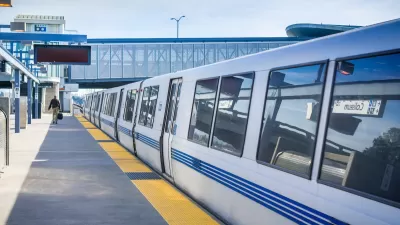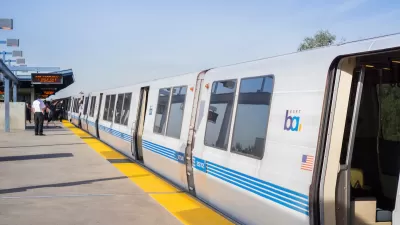Cost control and revenue generation measures prevented service cuts.

Through a combination of cost controls and revenue generation, Bay Area Rapid Transit has avoided a $35 million deficit that was originally projected for the 2026 fiscal year. Mass Transit reports that the deficit was eliminated without service cuts.
“According to BART, at the height of the pandemic when it closed rail services at 9:00 p.m., it represented a 40 percent cut in service, but it only reduced operating costs by 12 percent. The agency notes that even a 90 percent cut in service (9:00 p.m. closure, one-hour frequencies and running only three of the five BART lines) would close less than half of the FY 2027 $376 million deficit,” Mass Transit writes.
Instead, cost control and revenue generation measures included hiring freezes, running shorter trains, fare evasion reduction efforts, and inflation-based fare increases.
See a full list of the cost and revenue measures in the article below.
FULL STORY: BART eliminates projected $35 million budget deficit for FY26

Manufactured Crisis: Losing the Nation’s Largest Source of Unsubsidized Affordable Housing
Manufactured housing communities have long been an affordable housing option for millions of people living in the U.S., but that affordability is disappearing rapidly. How did we get here?

Americans May Be Stuck — But Why?
Americans are moving a lot less than they once did, and that is a problem. While Yoni Applebaum, in his highly-publicized article Stuck, gets the reasons badly wrong, it's still important to ask: why are we moving so much less than before?

Using Old Oil and Gas Wells for Green Energy Storage
Penn State researchers have found that repurposing abandoned oil and gas wells for geothermal-assisted compressed-air energy storage can boost efficiency, reduce environmental risks, and support clean energy and job transitions.

Greening Oakland’s School Grounds
With help from community partners like the Trust for Public Land, Oakland Unified School District is turning barren, asphalt-covered schoolyards into vibrant, green spaces that support outdoor learning, play, and student well-being.

California Governor Suspends CEQA Reviews for Utilities in Fire Areas
Utility restoration efforts in areas affected by the January wildfires in Los Angeles will be exempt from environmental regulations to speed up the rebuilding of essential infrastructure.

Native American Communities Prepare to Lead on Environmental Stewardship
In the face of federal threats to public lands and conservation efforts, indigenous groups continue to model nature-centered conservation efforts.
Urban Design for Planners 1: Software Tools
This six-course series explores essential urban design concepts using open source software and equips planners with the tools they need to participate fully in the urban design process.
Planning for Universal Design
Learn the tools for implementing Universal Design in planning regulations.
Heyer Gruel & Associates PA
City of Moreno Valley
Institute for Housing and Urban Development Studies (IHS)
City of Grandview
Harvard GSD Executive Education
Salt Lake City
NYU Wagner Graduate School of Public Service
City of Cambridge, Maryland





























